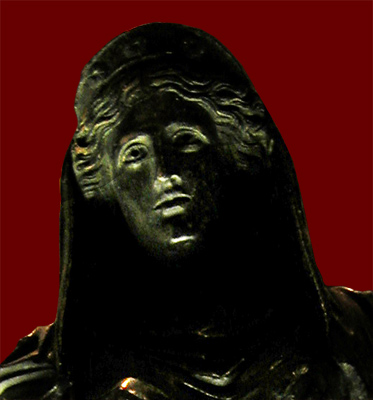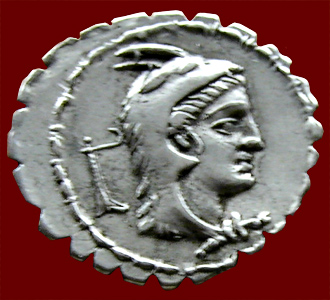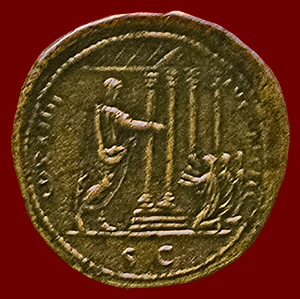Juno: Protective Roman
Goddess
 |
| head of a bronze statuette of Juno,
1st-3rd century CE |
Juno had many titles and temples in Republican Rome, most of which
reflected her role as protector of the city as well as of women, especially in
marriage and childbirth (as Juno Lucina and Juno Opigena). As
Juno Regina, queen of gods and men, she was part of the Capitoline
Triad. In her own right, however, Juno Regina played an important part in the
Roman conquest of Italy. As reigning goddess of Etruscan Veii, she was invited
(through an archaic ritual known as evocatio) by the Roman general
Lucius Furius Camillus to transfer her protection to Rome with the promise of a
bigger and better temple on the Aventine Hill in Rome. After his victory at
Veii, Camillus built the temple and dedicated it in 392 BCE, solemnly
installing there Juno's cult statue from Veii. Another temple to Juno Regina
was vowed by Marcus Aemilius Lepidus during the Ligurian Wars and dedicated in
the Circus Flaminius area of the Campus Martius in 179 BCE after the Roman
victory. During the wars with Carthage, Juno was frequently placated in special
rituals involving the matrons of Rome, perhaps because she was identified with
Astarte, the patron goddess of Carthage. In fact, Juno was ritually summoned
out of Carthage (evocatio) before the city was destroyed by the Romans
in 146 BCE.
 |
 |
| Juno Sospita, coin of L. Procilius,
80 BCE |
Juno Sospita, coin of L. Papius, 79
BCE |
Juno Sispes or Sospita (“Savior”) was the patron
deity of Lanuvium, a Latin town south of Rome, and her aid was especially
invoked in the pacification of the rebellious Latins. Later Juno Sospita was
seen as special protector of the city of Rome during war, and she was depicted
wearing a horned goatskin helmet and brandishing shield and spear. Her temple
in the Forum Holitorium was vowed by the consul C. Cornelius Cethegus in
thanksgiving for a victory over enemy tribes in Cisalpine Gaul and was
dedicated in 194 BCE. As Juno Curritis/Curitis/Quiritis (“Protector
of Spearmen”), she was worshipped by the 30 curiae (archaic
military and political administrative groups), with a temple or shrine in the
Campus Martius.
 |
 |
| The worship of Juno was particularly associated with Roman matrons;
on this sestertius of Domitian in honor of the Secular Games held in 88 CE, the
emperor is dictating a prayer to Juno to the matrons kneeling in front of him.
During the Matronalia, elebrated on March 1, matrons offered prayers to Juno
and her son Mars at the Temple of Juno Lucina on the Esquiline. On this feast
day, husbands traditionally gave their wives presents, and female slaves were
given special meals and relieved of work. |
Juno is frequently depicted standing, wearing a diadem and/or a
veil, and holding a scepter and a libation bowl (patera). This full-size
marble statue in the Vatican is a Roman copy of a Greek cult statue of Hera; it
is commonly referred to as the “Barberini Juno.” |
Close this window after viewing.
Barbara F. McManus





